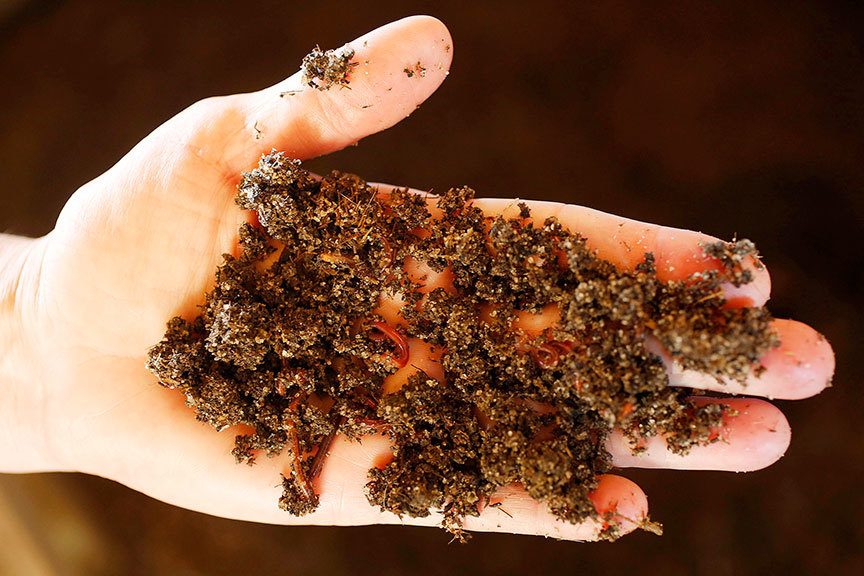RALEIGH, N.C. — Rhonda Sherman knows worms.
This wasn’t intentional — not really.
In 1980, when she was in college in her native Michigan, Sherman chose solid waste management. She started out correlating contaminated groundwater with area landfills as an employee of a five-county government council even before she had her master’s degree — and she was hooked.
Her mission, as she saw it, was to keep waste out of landfills.
In 1990, she escaped Michigan’s cold winters for North Carolina. She worked as a recycling coordinator and educator for UNC-Chapel Hill and then the state government before N.C. State University hired her on the first day of 1993. It was there that she found worms.
“I accidentally became famous for vermicomposting,” Sherman confesses. “It was never intentional.”
Her boss at the time, she recalls, had a “publish or perish” attitude toward university work, so Sherman came up with seven factsheet topics.
The final idea, a guide to letting worms recycle your garbage, made the engineers she worked with chuckle, but it proved the most popular. It flew off the shelves and had to be reprinted.
Today, Sherman is a vermiculture and vermicompost expert — again, she knows worms.
Sherman, who is also the president of the N.C. Composting Council, wasn’t the first to popularize vermiculture.
Interestingly, one of its early champions is Mary Appelhof, who also lived in Sherman’s hometown of Kalamazoo. Appelhof was two decades older than Sherman and the two knew each other, but young Sherman had little interest in vermicomposting — not as a student, at least.
Appelhof’s book “Worms Eat My Garbage” popularized vermiculture in homes and schools. Sherman’s work has expanded the scope of the subject, and her focus is on large-scale vermicomposting. Every year, in fact, she holds a two-day conference on the topic, which draws international attendees.
Sherman shared some tips on how to vermicompost, both on the large and small scale.
Why vermicompost?
“I do get on a soapbox when it comes to talking about food waste,” Sherman says. “Food waste should absolutely not go in the garbage or go down the drain — period.”
Composting of any kind is easy, she notes, while food waste can be problematic in landfills and wastewater treatment plants. In septic tanks, too, food waste can cause the tank to need pumping out more often, she says, costing homeowners more money. Composting can turn this “trash” into a beneficial product.
Another reason is for plant health. “In the home and in schools, they can use vermicompost to make healthier, more resilient plants that germinate more quickly and repel pests and diseases,” Sherman says.
Manure: Farms can vermicompost manure and turn it into something even more valuable, Sherman says, and worms dramatically increase compost’s worth.
“If you were going to manufacture compost and sell it, you can sell it for anything from zero up to about $30 per cubic yard,” she says. “Vermicompost, same amount, you can sell for a minimum of $400 a cubic yard. I have seen it sold for $1,800 a cubic yard.”
The worm bin: A pre-made worm bin will cost between $30 and $120, Sherman says, or you can make your own: Just buy a 10- or 14-gallon plastic storage bin and drill holes in it. Sherman goes into excellent detail on where and how to drill in “Worms Can Recycle Your Garbage,” which is online at content.ces.ncsu.edu/worms-can-recycle-your-garbage.
The worms: “The most expensive thing is to buy the worms,” Sherman says. “There are over 9,000 species of earthworms and you have to make sure you’re using a species that’s appropriate for living in a worm bin.”
The preferred species is eisenia fetidia, or red wigglers. Don’t go to bait shops, though, as a worm bin would require dozens of bait cups’ worth of worms. Instead, buy them by the pound from an earthworm grower. You can ask your local cooperative extension agent where to buy worms locally.
Bedding: “You need to put some kind of bedding in your worm bin,” Sherman says. “A lot of people will use newspaper.” If you have children, she suggests holding a newspaper shredding party. Shred the paper, soak it in water for about 10 minutes, squeeze it out and put it in the worm bin.
How to: At an easy five pages, Sherman’s “Worms Can Recycle Your Garbage” factsheet (again, at content.ces.ncsu.edu/worms-can-recycle-your-garbage) is a quick and essential roundup of vermicomposting’s basics. For those who want more depth, there’s Appelhof’s book or Sherman’s conferences and sessions.
Talk to us
> Give us your news tips.
> Send us a letter to the editor.
> More Herald contact information.

























